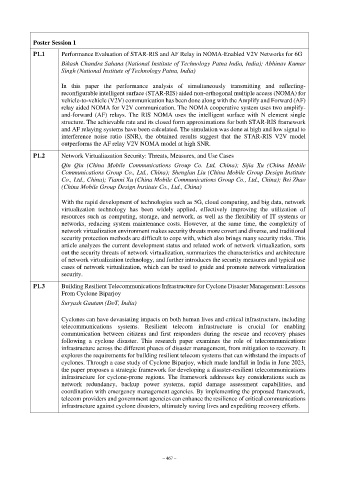Page 511 - Kaleidoscope Academic Conference Proceedings 2024
P. 511
Poster Session 1
P1.1 Performance Evaluation of STAR-RIS and AF Relay in NOMA-Enabled V2V Networks for 6G
Bikash Chandra Sahana (National Institute of Technology Patna India, India); Abhinav Kumar
Singh (National Institute of Technology Patna, India)
In this paper the performance analysis of simultaneously transmitting and reflecting-
reconfigurable intelligent surface (STAR-RIS) aided non-orthogonal multiple access (NOMA) for
vehicle-to-vehicle (V2V) communication has been done along with the Amplify and Forward (AF)
relay aided NOMA for V2V communication. The NOMA cooperative system uses two amplify-
and-forward (AF) relays. The RIS NOMA uses the intelligent surface with N element single
structure. The achievable rate and its closed form approximations for both STAR-RIS framework
and AF relaying systems have been calculated. The simulation was done at high and low signal to
interference noise ratio (SNR), the obtained results suggest that the STAR-RIS V2V model
outperforms the AF relay V2V NOMA model at high SNR.
P1.2 Network Virtualiazation Security: Threats, Measures, and Use Cases
Qin Qiu (China Mobile Communications Group Co. Ltd, China); Sijia Xu (China Mobile
Communications Group Co., Ltd., China); Shenglan Liu (China Mobile Group Design Institute
Co., Ltd., China); Tianni Xu (China Mobile Communications Group Co., Ltd., China); Bei Zhao
(China Mobile Group Design Institute Co., Ltd., China)
With the rapid development of technologies such as 5G, cloud computing, and big data, network
virtualization technology has been widely applied, effectively improving the utilization of
resources such as computing, storage, and network, as well as the flexibility of IT systems or
networks, reducing system maintenance costs. However, at the same time, the complexity of
network virtualization environment makes security threats more covert and diverse, and traditional
security protection methods are difficult to cope with, which also brings many security risks. This
article analyzes the current development status and related work of network virtualization, sorts
out the security threats of network virtualization, summarizes the characteristics and architecture
of network virtualization technology, and further introduces the security measures and typical use
cases of network virtualization, which can be used to guide and promote network virtualization
security.
P1.3 Building Resilient Telecommunications Infrastructure for Cyclone Disaster Management: Lessons
From Cyclone Biparjoy
Suryash Gautam (DoT, India)
Cyclones can have devastating impacts on both human lives and critical infrastructure, including
telecommunications systems. Resilient telecom infrastructure is crucial for enabling
communication between citizens and first responders during the rescue and recovery phases
following a cyclone disaster. This research paper examines the role of telecommunications
infrastructure across the different phases of disaster management, from mitigation to recovery. It
explores the requirements for building resilient telecom systems that can withstand the impacts of
cyclones. Through a case study of Cyclone Biparjoy, which made landfall in India in June 2023,
the paper proposes a strategic framework for developing a disaster-resilient telecommunications
infrastructure for cyclone-prone regions. The framework addresses key considerations such as
network redundancy, backup power systems, rapid damage assessment capabilities, and
coordination with emergency management agencies. By implementing the proposed framework,
telecom providers and government agencies can enhance the resilience of critical communications
infrastructure against cyclone disasters, ultimately saving lives and expediting recovery efforts.
– 467 –

